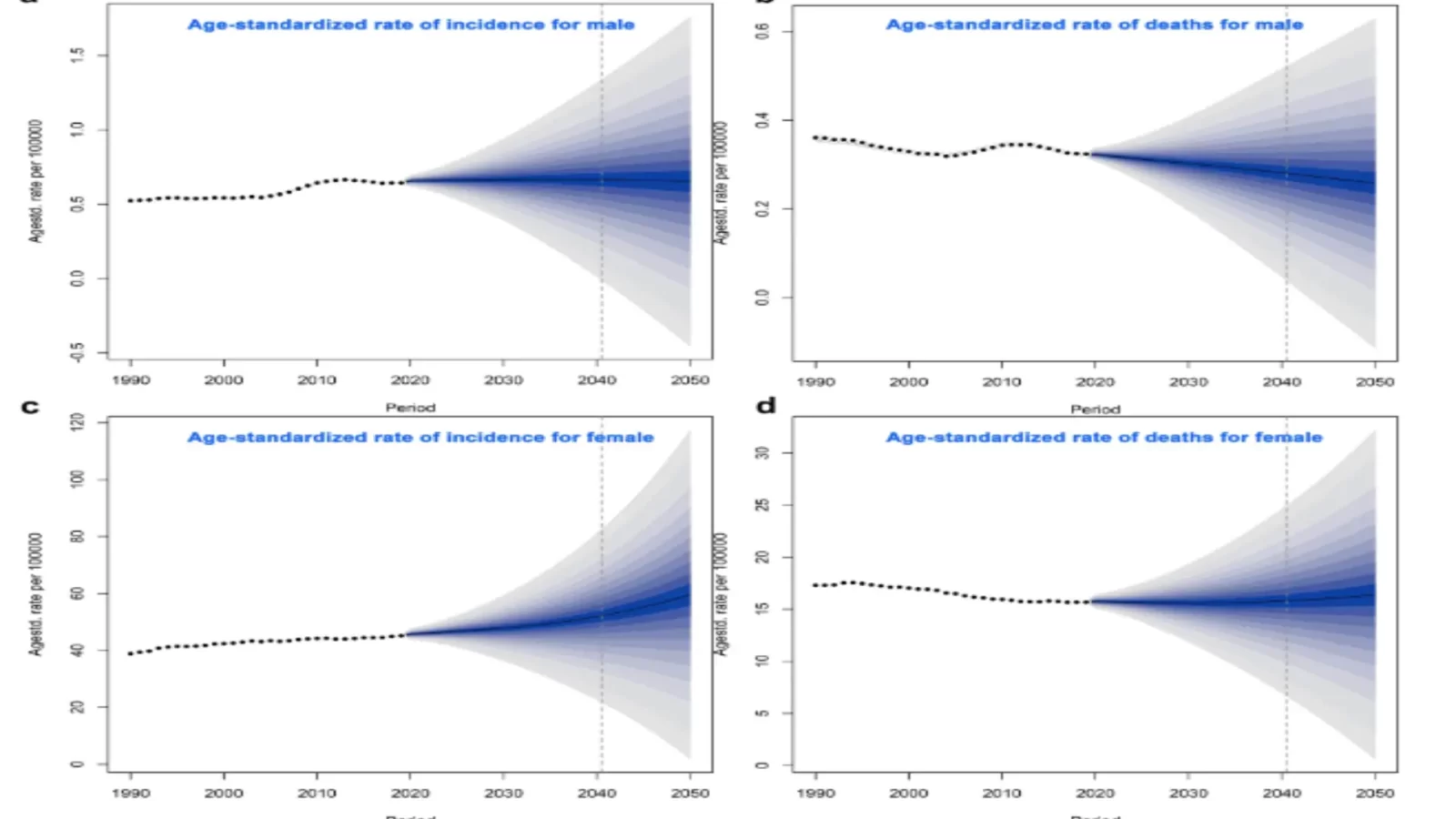Understanding Breast Cancer Symptoms: A Comprehensive Guide
Key facts
According to WHO Reports In 2020, there were 2.3 million women diagnosed with breast cancer and 685 000 deaths globally. As of the end of 2020, there were 7.8 million women alive who were diagnosed with breast cancer in the past 5 years, making it the world’s most prevalent cancer. Breast cancer occurs in every country of the world in women at any age after puberty but with increasing rates in later life
- Breast cancer caused 685 000 deaths globally in 2020.
- Roughly half of all breast cancers occur in women with no specific risk factors other than sex and age.
- Breast cancer occurs in every country in the world.
- Approximately 0.5–1% of breast cancers occur in men.
When it comes to breast cancer, awareness and early detection are crucial. In this comprehensive guide, we delve into the various symptoms associated with breast cancer, shedding light on the nuances that individuals need to recognize. Our aim is to provide valuable insights that empower readers with knowledge about potential signs and types of breast cancer.
Recognizing Early Warning Signs
1. Breast Lumps: The Primary Indicator
The most common and often the earliest sign of breast cancer is a palpable lump in the breast or armpit. These lumps may be identified through regular self-examinations or mammograms, with early detection significantly improving prognosis.
2. Swelling: An Indication of Spreading
Swelling in the armpit or near the collarbone may precede the detection of a lump, indicating possible lymph node involvement. This underlines the importance of reporting any unexplained swelling to your healthcare provider promptly.
3. Pain and Tenderness: Unveiling Hidden Symptoms
While breast lumps typically aren’t painful, some may cause a prickly sensation. Understanding that pain and tenderness can accompany breast cancer symptoms emphasizes the need for thorough medical assessment.
4. Changes in Breast Appearance: A Visual Cue
Alterations in breast size, contour, texture, or temperature could be indicative of an underlying issue. Regularly monitoring and noting any changes in breast appearance is crucial for early detection.
5. Nipple Changes: Recognizing Abnormalities
Changes in the nipple, such as inward pulling, dimpling, burning, itching, or the development of sores, should be closely observed. These changes may be early signs of breast abnormalities.
6. Unusual Nipple Discharge: Understanding Variations
Nipple discharge, whether clear, bloody, or another color, can signal an issue. Recognizing and reporting any unusual discharge is vital for comprehensive breast health.
7. Unique Indicators: Marble-like Areas and Flat/Indented Regions
Anomalies like a marble-like area under the skin or flat/indented regions on the breast surface require attention. These subtle signs could be associated with hidden tumors that need evaluation.
Exploring Breast Cancer Types and Corresponding Symptoms
1. Ductal Carcinoma: The Common Culprit
Ductal carcinoma, the most prevalent type, may not exhibit noticeable symptoms. However, it can manifest as a breast lump or bloody discharge, emphasizing the need for regular screenings.
2. Lobular Carcinoma: Identifying Unique Signs
Originating in the milk-producing glands, lobular carcinoma may present as fullness, thickening, or inverted nipples. Recognizing these distinctive signs aids in early diagnosis.
3. Invasive Breast Cancer: Unmasking Visible Clues
Invasive breast cancer, spreading beyond its origin, may showcase symptoms like skin changes, breast asymmetry, rashes, and swollen lymph nodes. Prompt identification is critical for effective intervention.
4. Metastatic Breast Cancer: Vigilance Beyond Initial Treatment
Understanding the potential spread of breast cancer to other organs highlights the importance of vigilance. Recognizing symptoms like bone pain, headaches, and organ-specific issues is crucial for addressing metastasis.
5. Triple-Negative Breast Cancer: A Unique Challenge
Triple-negative breast cancer, lacking certain receptors, demands specialized attention due to its aggressive nature. Recognizing common symptoms and pursuing tailored treatment is imperative.
6. Male Breast Cancer: Overcoming Rarity
While rare, male breast cancer demands attention to symptoms like lumps, skin changes, and nipple abnormalities. Early recognition ensures timely intervention for improved outcomes.
7. Paget’s Disease and Inflammatory Breast Cancer: Identifying Rare Presentations
Recognizing symptoms of Paget’s disease (eczema-like changes) and inflammatory breast cancer (infection-like symptoms) is crucial, albeit their rarity. Timely diagnosis facilitates appropriate management.
Addressing Common Concerns: Breast Lumps
Breast lumps are often benign, arising from conditions like fibroadenoma, fibrocystic changes, infections, or injuries. Distinguishing between benign and malignant lumps is pivotal, with timely medical consultation being paramount.
Navigating Breast Cancer Recurrence
Understanding the possibility of breast cancer recurrence, whether local, regional, or metastatic, emphasizes the need for ongoing vigilance. Recognizing specific symptoms associated with each recurrence type is crucial for timely intervention.
Future Forecasts of Global Burden of Disease in Breast Cancer: A Comprehensive Overview
Explore the future forecasts of global burden of disease in breast cancer, backed by Figure 5 projections. Understand the ASR trends, incidence rates, and mortality estimates by 2050. Gain insights into the anticipated challenges and advancements in combating breast cancer worldwide.
Breast cancer, a pervasive global health concern, demands an in-depth analysis of future projections. Figure 5 presents compelling data, revealing trends in the Age-Standardized Rates (ASR) of breast cancer incidence and mortality. This article delves into the forecasted statistics, exploring the nuances of the anticipated burden and providing valuable insights for both professionals and the general public.
The ASR of Breast Cancer Incidence: A Gradual Surge
Explore the gradual increase in the ASR of breast cancer incidence worldwide. By 2050, the ASR in females is estimated to reach 59.63 per 100,000, marking a significant 32.13% surge from 2019. Males, too, witness an increase, albeit at 0.65 per 100,000, reflecting a 1.74% rise compared to 2019.
Estimating Global Breast Cancer Deaths
Delve into the projections of ASR for global breast cancer deaths from 2020 to 2050. While the ASR in female deaths experiences a slight increase, the ASR in male deaths gradually decreases. Anticipated statistics for 2050 suggest a 16.42/100,000 ASR in female deaths, showcasing a 4.69% rise, and a decrease to 0.26 cases per 100,000 in male deaths, marking a notable 19.84% decline from 2019.
United Nations World Population Forecast: A Glimpse into 2050
Explore the broader context with insights from the United Nations world population forecast data. By 2050, the projected global burden of breast cancer encompasses 4,781,849 incident cases, affecting 4,714,393 women and 67,456 men. Additionally, an estimated 1,503,694 death cases are anticipated, comprising 1,481,463 women and 22,231 men.
The Global Impact: Challenges and Opportunities
Uncover the challenges posed by the escalating burden of breast cancer globally. As incidence rates rise, it becomes imperative to address issues related to healthcare infrastructure, awareness, and accessible treatments. However, these challenges also present opportunities for advancements in research, early detection methods, and improved patient care.
Proactive Measures: A Call to Action
Recognize the urgency for proactive measures in the face of the escalating burden of breast cancer. Governments, healthcare organizations, and communities must collaborate to enhance preventive strategies, promote awareness, and ensure widespread access to screening and treatment facilities.
Embracing Innovations: Technology and Research
Highlight the role of technological innovations and ongoing research in mitigating the future burden of breast cancer. From advancements in early detection technologies to breakthroughs in personalized treatment modalities, the landscape of breast cancer management is evolving, offering hope for a better future.

FAQs
Q: How accurate are the projections in Figure 5?
The projections in Figure 5 are based on meticulous analysis and modeling, considering various factors influencing breast cancer incidence and mortality rates. While they provide valuable insights, projections are subject to change based on evolving healthcare landscapes and interventions.
Q: What proactive measures can individuals take to reduce breast cancer risk?
Individuals can adopt a proactive approach by prioritizing regular screenings, maintaining a healthy lifestyle, and being aware of genetic factors. Early detection significantly improves treatment outcomes, emphasizing the importance of routine check-ups.
Q: Are there disparities in breast cancer burden among different regions?
Yes, breast cancer burden exhibits variations across regions, influenced by factors such as healthcare accessibility, awareness, and genetic predispositions. Addressing these disparities requires targeted interventions tailored to the specific needs of diverse populations.
Q: How can technology contribute to breast cancer management?
Technological innovations, including advanced imaging techniques and genetic testing, play a pivotal role in early detection and personalized treatment plans. Integrating these technologies into healthcare systems enhances diagnostic accuracy and improves patient outcomes.
Q: What role does the United Nations play in addressing the global burden of breast cancer? The United Nations serves as a crucial platform for coordinating international efforts to tackle global health challenges, including breast cancer. Collaborative initiatives and resource allocation contribute to fostering a unified approach in combating the disease.
Q: Are there ongoing initiatives to raise awareness about breast cancer globally?
Numerous global initiatives focus on raising awareness about breast cancer, emphasizing the importance of early detection, regular screenings, and destigmatizing discussions around the disease. These campaigns aim to empower individuals to take charge of their health.
Conclusion
As we navigate the future forecasts of the global burden of breast cancer, it is evident that proactive measures, technological advancements, and international collaboration are imperative. By understanding the projections and addressing challenges head-on, we can collectively strive towards a future with reduced breast cancer incidence and improved outcomes.In conclusion, this comprehensive guide serves as a valuable resource for understanding and recognizing various breast cancer symptoms. Empowering individuals with knowledge is key to fostering early detection and, subsequently, improved outcomes. Regular self-examinations, awareness of symptoms, and timely medical consultation are pivotal in the fight against breast cancer.
Global trends and forecasts of breast cancer incidence and deaths
























